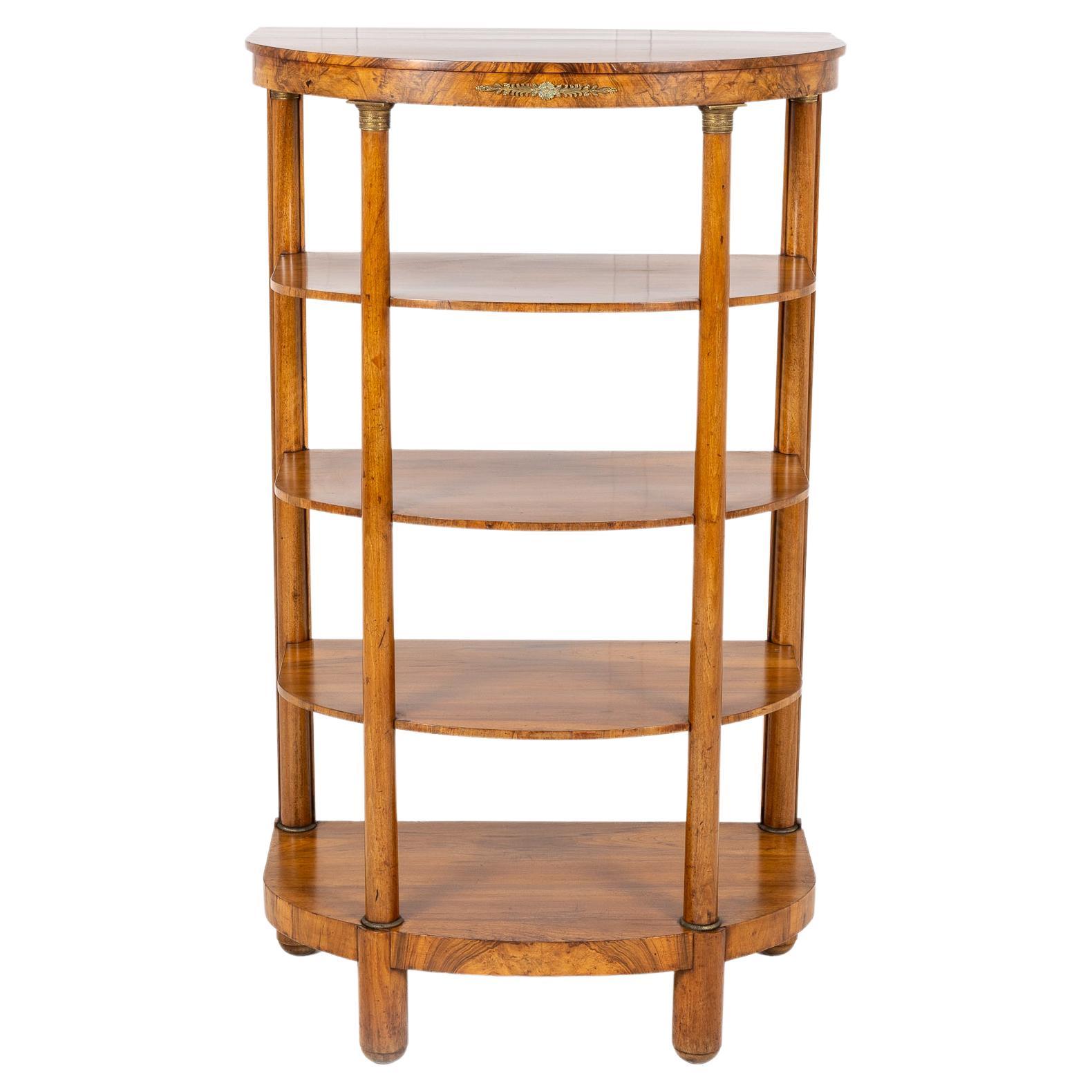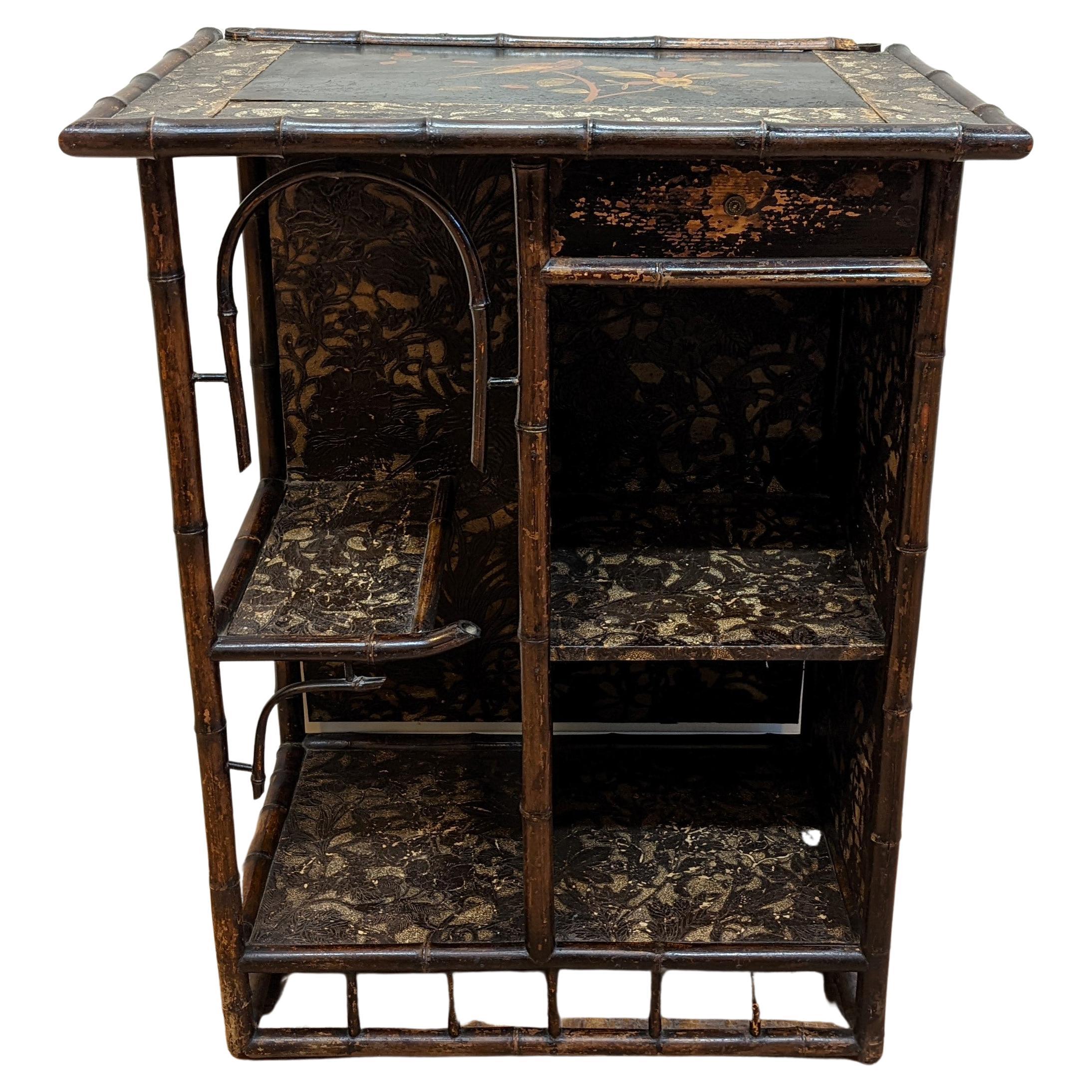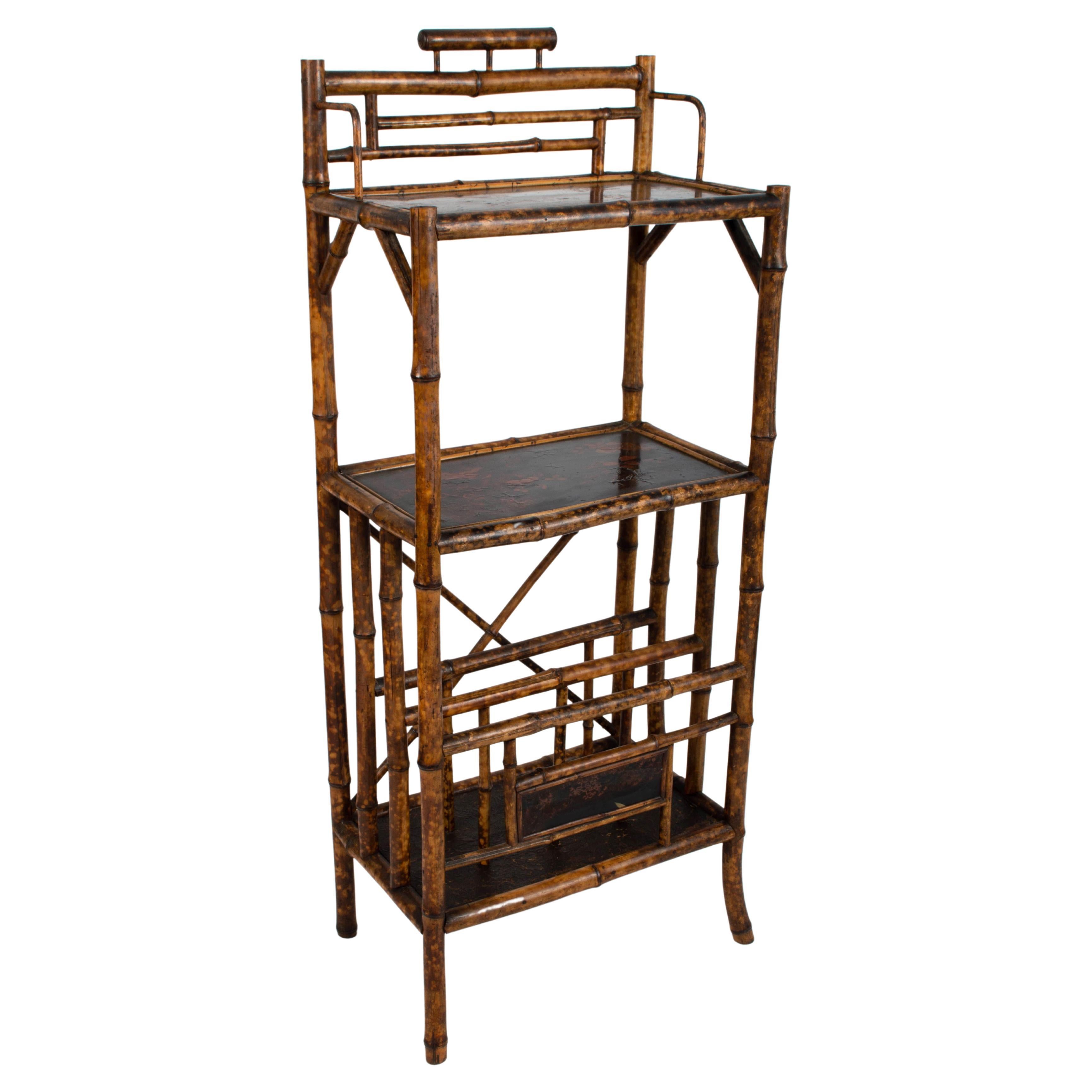Items Similar to Antique 19th Century Bamboo Lacquered Display Stand, Perret And Vibert, France
Want more images or videos?
Request additional images or videos from the seller
1 of 12
Antique 19th Century Bamboo Lacquered Display Stand, Perret And Vibert, France
About the Item
Antique 19th Century Bamboo Lacquered Display Stand, Perret And Vibert, France.
C.1880
In very good condition commensurate of age.
- Attributed to:Perret et Vibert (Retailer)
- Dimensions:Height: 48.04 in (122 cm)Width: 18.12 in (46 cm)Depth: 10.24 in (26 cm)
- Style:Japonisme (In the Style Of)
- Materials and Techniques:
- Place of Origin:
- Period:
- Date of Manufacture:C.1880
- Condition:Wear consistent with age and use.
- Seller Location:London, GB
- Reference Number:1stDibs: LU5559239466872
About the Seller
5.0
Gold Seller
These expertly vetted sellers are highly rated and consistently exceed customer expectations.
1stDibs seller since 2020
90 sales on 1stDibs
Typical response time: <1 hour
- ShippingRetrieving quote...Ships From: London, United Kingdom
- Return PolicyA return for this item may be initiated within 1 day of delivery.
More From This SellerView All
- Antique 19th Century Lacquered Etagere Perret And Vibert, FranceBy Perret et VibertLocated in London, GBAntique 19th Century Lacquered Etagere Perret And Vibert, France C.1890 In very good condition commensurate of age.Category
Antique 19th Century Japonisme Shelves
MaterialsFruitwood, Lacquer
- Antique 19th Century Anglo-Chinese Lacquered Bamboo Etagere Shelves, EnglandLocated in London, GBAntique 19th century Anglo-Chinese lacquered bamboo etagere shelves. C.1880 England In very good condition, with expected signs of wear commensurate with age.Category
Antique 19th Century English Chinese Chippendale Shelves
MaterialsBamboo, Lacquer
- Mid Century French Shelving Display Cabinet Bookcase C.1970, Pierre Vandel ParisBy Pierre VandelLocated in London, GBMid century French shelving display cabinet bookcase C.1970. PIERRE VANDEL, PARIS: A black and gilt lacquered display cabinet, the frame form supers...Category
Mid-20th Century French Mid-Century Modern Shelves
MaterialsAluminum
- Antique English 19th Century Sheraton Revival Mahogany Display Cabinet on StandLocated in London, GBAntique English 19th century Sheraton revival mahogany display cabinet on stand. A 19th century mahogany display cabinet on stand,...Category
Antique 19th Century English Sheraton Vitrines
MaterialsGlass, Mahogany
- Mid Century Bamboo and Rattan Étagère Shelves, Italy, circa 1960Located in London, GBA Mid Century bamboo and rattan three-tier Italian étagère (shelves) dating from the 1960s. In excellent condition commensurate of age.Category
Mid-20th Century Italian Mid-Century Modern Shelves
MaterialsBamboo, Rattan
- Mid Century Italian Bamboo Rattan Shelf C.1960Located in London, GBMid Century Italian Bamboo Rattan Shelf C.1960 In good condition commensurate of age.Category
Mid-20th Century Italian Mid-Century Modern Shelves
MaterialsBamboo, Rattan
You May Also Like
- 19th Century Bamboo and Rosewood Lacquered ÉtagèreLocated in New York, NYBamboo and rosewood (19th Century) lacquered panel etagere with 3 doors with floral and figural decoration.Category
Antique 19th Century Unknown Japonisme Shelves
MaterialsBamboo, Rosewood
- 19th Century French Walnut Display Stand / ÉtagèreLocated in Gloucestershire, GBAn unusual French 19th century étagère/display stand or 'whatnot' with four shelves and embellished frieze at the top, constructed in walnut. The D-shaped tiers are supported by turn...Category
Antique 19th Century Shelves
MaterialsWalnut
- 19th Century Bamboo Lacquered Hall Table ShelfLocated in New York, NY19th century hall table also called Half Table. Bamboo construction with embossed paper lacquered to the wooden flats that make up the shelfs and walls. Chinoiserie style painting to...Category
Antique Early 1900s Chinese Qing Shelves
MaterialsPaper, Bamboo, Wood
- Japanese Style Cabinet-Secretary Att. to Perret & Vibert, France, circa 1880By Perret et VibertLocated in PARIS, FRA Japanese style carved wood cabinet, with a painted decor imitating Japanese lacquer, ornamented with flowers, birds and butterflies. Opening onto two drawers and a paper filer, the upright-secretary door is also fitted with red velvet. Surmounted by a drawer and asymmetrical shelves, composed in the Japanese « zen » spirit, the cabinet stands on four legs joined by an engraved stretcher. The great influence of the Far-East, through China and Japan, in the second half of the 19th century French art could be found first in painting and soon after in decorative arts and furniture as well. Following the Franco-English military campaign led in 1860 against the Imperial army in China, the French troops of Napoleon III brought back from the Summer Palace, a part of the Chinese Imperial court treasure, which will make up the famous Chinese Museum of Empress Eugénie at the Fontainebleau Palace. The French artists won’t be long to take inspiration from those exotic and sumptuous objects for their creations, as they used to do in the 18th century, when the best French cabinet-makers adapted the Chinese lacquers on the luxurious royal chests. But the influence of Japan, at the Meiji period (1868-1912), came also very quickly to France, thanks to the opening of the country in the middle of the 19th century, as well as the development of traveling and the amazing Universal Exhibitions, in which Japan participated for the first time in 1867 in Paris. Then many Japanese objects and prints were imported to France and to all Europe, and for which some collectors spent already fortunes. With Manet and Impressionists generation, the passion for Japanese art, more than a simple taste for an exotic style, was still in fashion until the turn of the 19th century. It provoked not only a craze among the French aristocratic families as well as the wealthy Paris high society, wishing renew their mansion inner decoration, but turned also to a real revolutionary movement among the “avant-garde” artists. Those artists, whoever they were, painters, cabinet-makers or designers of ceramic, bronze and crystal objects, adapted then those techniques and naturalistic motifs unknown until this time. Christofle, very famous since 1867 as a silversmith, was also one of the leaders among the inventors of Japanism. He knew how to use Japanese elements to his own splendid works made in silver or “cloisonné” enameled bronze. During the 1878 Paris Universal Exhibition, Christofle presented with great success his life-sized bronze Japanese ladies torcheres, executed by the renowned sculptor Guillemin. Another famous company to be mentioned, is “L’Escalier de Cristal”, producing art objects and furniture, all of high standard quality and innovating much with their Japanese decor. Highly remarked during the Universal Exhibitions, “L’Escalier de Cristal” collaborated with the greatest artists, such Gallé and Rousseau for glass- and ceramic wares, and the cabinet-makers Lièvre and Viardot, whom made furniture including sometimes authentic Japanese elements. In 1872, Alfred Perret and Ernest Vibert opened in Paris, at 33 rue du Quatre-Septembre a store that offered “natural bamboo furniture and cane seats” and all kinds of textile fittings for furniture. This furniture used for winter gardens and terraces of mansions knew then a resounding success. They developed their business around 1884 with their Japanese style furniture, very close to that executed by Gabriel Viardot (1830-1906). In 1886, the company appearing in the category of “Chinoiserie and Japoneries” offered, in addition to furniture and seating creation, works of art and inlaid furniture directly imported from the Far East ; an activity that expanded rapidly. Their exotic fantasy furniture presented at the Universal Exhibition of Paris in 1889 and 1900, rewarded them two silver medals. In 1894, the company was listed under the name “Perret et Vibert”, headed by the son of Alfred Perret and Ernest Vibert. The same year, they redesigned their store on rue du Quatre-Septembre, creating ten new show-rooms, showing complete furniture sets of Japanese and Chinese style inspiration. It was not until 1895, that the company was finally named “La Maison des Bambous” and organized then in their shops an “exhibition of country furniture and seats for castles and villas”, which was visited by Empress Eugenie to furnish her villa Cyrnos at Cap Martin. She actually was a regular customer of the “Maison des Bambous” as she bought repeatedly furniture. In October of the same year, the king of Greece...Category
Antique 1880s French Japonisme Secretaires
MaterialsWood
- 19th Century Antique Four Tier Bamboo RackLocated in Charleston, SCAntique bamboo etagere shelf stand. The Victorian era stand features a bamboo frame with four wood shelves. Around late 19th century to early 20th centuryCategory
Antique 19th Century English Victorian Shelves
MaterialsBamboo, Wood
- 19th Century Bamboo EtagereLocated in West Palm Beach, FLFashioned with lacquered panels painted with birds and florals and generously scaled shelves. A versatile bamboo shelving unit. The piece is topp...Category
Antique 19th Century English Shelves
MaterialsBamboo, Lacquer
Recently Viewed
View AllMore Ways To Browse
Bamboo And Lacquered Furniture
Perret And Vibert
Lacquer And Bamboo
French Lacquered Bamboo Furniture
Vibert Perret
Bamboo Display Cabinet
Archie Kaplan
Billy Baldwin Etagere
Brass Bistro Shelves
British Colonial Etagere
English Edwardian Etagere
Glass Wall Shelf 18 Wide
Gold Wrought Iron Console Cabinet
Maison Regain Bed
Outdoor Potting Station
Parade Wall Shelf
Pastry Display Case
Poul Cadovius Basket Weave





